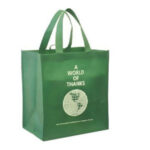The average restaurant produces about 8,200 pounds of waste a month, which is more than 98,000 pounds a year. About 15 percent of that waste is in the form of reusable materials. That means nearly 15,000 pounds of waste per month can be completely eliminated. That’s a staggering amount once you factor in the amount of fast food restaurants that are out there. So what are the best ways to recycle all the waste created by fast food?
Fast food waste comes in several forms. Plastic eating utensils, Styrofoam cups and containers, wrappers and napkins make up the bulk of recyclable material that is tossed into the trash in fast food joints. There’s also a lot of waste being generated on the other side of the counter. Packing materials, cleaning products, gas, water and electricity are a few examples.
With the enormous amount of waste produced by fast food restaurants, one would think that there would be a set of laws in place to curb it. Currently, there are no federal laws to mandate the recycling of waste from any restaurant. Any recycling done is purely on a volunteer basis. The cost of recycling food- contaminated waste is steep and many cities simply don’t have the resources to accomplish it. Right now, customers have only two options: take the materials home and recycle them or throw them away at the restaurant.
Between the store, the government and the customer, there are a number of ways to recycle fast food. Most of the effort must be from the restaurant itself, however. While many view recycling as inefficient and cost prohibitive, there are enough ways to save money to make it all worthwhile to owners.
The first step is to set up a recycling program for grease, cardboard products, plastic and glass with a local collector. Then put bins in areas of eating establishments where customers can access them easily. Keep in mind that most cities don’t currently accept food-tainted materials, which often makes recycling very expensive for restaurants. Also, put bins and receptacles behind the counter for employees to use. You can’t recycle material unless you collect it first. Also, contact local farms and compost facilities about donating or selling food waste. Many fast food places throw out any uneaten food at the end of the day. Instead, edible food can be donated to local shelters.
The best way to cut down on the amount of waste created by restaurant is to reduce the amount available in the restaurant. Businesses can cut down on the amount of packaging they use and use straw dispensers instead of using individually wrapped straws to help reduce paper consumption. Instead of using little plastic packets of ketchup and mustard, restaurants could use condiment dispensers. Restaurants can also give discounts on drink prices if they use their own cup. Changing take-out bags from colored paper to unbleached will help make restaurants a little greener as well. Many people don’t pay attention to the tiny little recycle symbol on things like cups and packaging. Clearly labeling these items will help remind folks how to best dispose of them.
There are ways for restaurants to recycle behind the scenes that customers won’t even know about. Fast food restaurants can purchase supplies made with post-consumer recycled content. Stop using paper hats and go with reusable ones. Instead of paper towels, use cloth ones for cleaning. Purchase products in bulk and rotate perishable food items to reduce spoilage. Businesses can also use fluorescent lights instead of incandescent ones. Also, installing motion-sensing lights in freezers and restrooms will curb excess waste. Installing water-conserving fixtures will help reduce water consumption. Using a monthly maintenance schedule for appliances and equipment will help them run more efficiently. Eating establishments can also use polypropylene based materials instead of polystyrene. While this doesn’t sound like a big deal, it can save countless thousands of barrels of oil per year. Better still; businesses can switch to biodegradable materials like cornstarch for all their cutlery and packaging, reducing waste to almost nothing. Lastly, restaurants can ask their vendors to ship materials in recycled materials.
We’ve looked at how restaurants and their customers can help recycle fast food, but what about governments? Governments can enact laws and levy fines on establishments that don’t toe the line. While there are many local governments that already have laws on the books regarding recycling, most aren’t enforced and those that are often don’t carry heavy enough fines to discourage wayward businesses.
Local and federal governments can enact and enforce laws banning businesses from dumping recyclable materials. Even if restaurants start small, by recycling only certain items and educating their customers, it will go a long way to getting folks involved. Officials can also stiffen fines significantly. Typically, only token fines of a few dollars are issued. If these fines were raised, it would encourage fast food restaurants to put more effort into their recycling programs. Governments can also offer subsidies to recycling centers that will take on more difficult materials like food-contaminated items. Monies from fines raised could help pay for those subsidies.
In the end, while most restaurants will claim that recycling is just too costly, it doesn’t have to be. Using more energy-efficient equipment will help offset the cost of recycling. Implementing biodegradable materials and selling non-edible foods to local animal farms will go a long way towards cutting the costs of waste removal. Most businesses will find that voluntarily getting a little greener and recycling doesn’t cost as much as they think.



